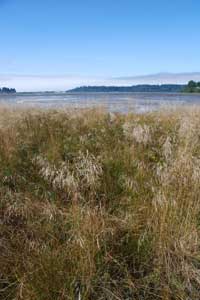
|
Figure A1. Photograph of tidal marsh dominated by Deschampsia cespitosa
(tufted hairgrass) at prioritization site A5, fig. 7
at Eckman Island in the Alsea estuary, Oregon. Photograph by Christopher
Janousek, U.S. Environmental Protection Agency, September 2010.
[larger version]
|
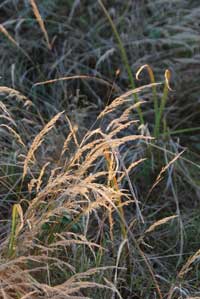
|
Figure A2. Photograph of Agrostis stolonifera (creeping bentgrass) at prioritization
site A31 in fig. 7
in the Alsea estuary, Oregon. Photograph by Christopher Janousek,
U.S. Environmental Protection Agency, September 2010. [larger version]
|
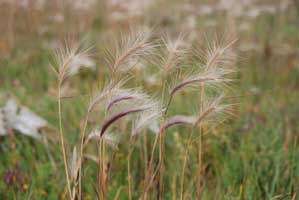
|
Figure A3. Photograph of Hordeum jubatum (foxtail barley) at prioritization
site Y1, fig. 6 in the Yaquina estuary, Oregon. Photograph by Christopher Janousek,
U.S. Environmental Protection Agency, August 2010. [larger version]
|
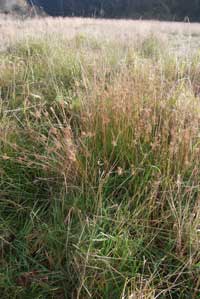
|
Figure A4. Photograph of Juncus effusus (common rush) at prioritization site
A24 in fig. 7
in the Alsea estuary, Oregon. This species tends to be found at
high elevations in lower salinity tidal marshes. Photograph by Christopher
Janousek, U.S. Environmental Protection Agency, November 2010. [larger version]
|
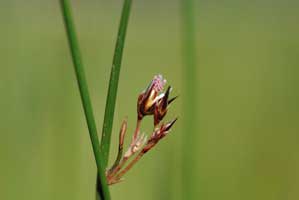
|
Figure A5.
Photograph of Juncus balticus ssp. ater (Baltic rush) at prioritization
site Y1 in fig. 6 in the Yaquina estuary, Oregon. Several species of rushes
are found in Oregon tidal wetlands. Baltic rush is the most frequently
encountered species in high marsh. Photograph by Christopher Janousek,
U.S. Environmental Protection Agency, May 2010. [
larger version ]
|
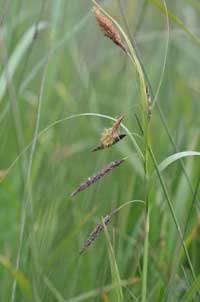
|
Figure A6. Photograph of Carex lyngbyei (Lyngybe’s sedge) at prioritization site Y40 in fig. 6 in Poole Slough, Yaquina estuary, Oregon. One of the most common tidal marsh species in the Pacific Northwest, Lyngybe’s sedge grows in both low and high marsh. Photograph by Christopher Janousek, U.S. Environmental Protection Agency, April 2011.
[larger version]
|
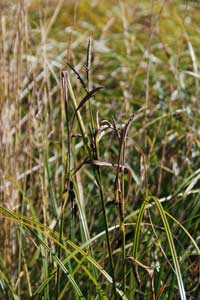
|
Figure A7. Photograph of Carex obnupta (slough sedge) at prioritization site A17 in
fig. 7 in the Alsea estuary, Oregon. Slough sedge grows in the
upper marsh in less saline regions of the estuaries and can also
be found in freshwater wetlands. Photograph by Christopher Janousek,
U.S. Environmental Protection Agency, September 2010.
[larger version]
|
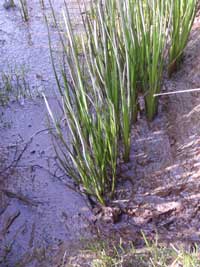
|
Figure A8. Photograph of Triglochin maritimum (seaside arrowgrass) at prioritization
site Y40 in fig. 6 in Poole Slough, Yaquina estuary, Oregon. Seaside arrowgrass
is a succulent perennial forb commonly found in low tidal marsh.
Photograph by Christopher Janousek, U.S. Environmental Protection
Agency, May 2010.[larger version]
|
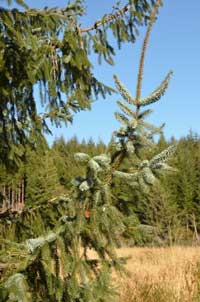
|
Figure A9.
Photograph of Picea sitchensis (Sitka spruce) at the edge of a marsh
along Drift Creek at prioritization site A28 in
fig. 7
in the Alsea estuary, Oregon. Sitka spruce is the principal foundation
species of brackish tidal swamps in Oregon. It can also be found
growing on nurse logs in estuarine marshes. Photograph by Christopher
Janousek, U.S. Environmental Protection Agency, December 2011.
[larger version]
|
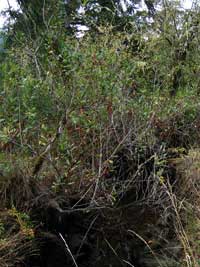
|
Figure A10.
Photograph of black twinberry (Lonicera involucrata) growing
on the bank of a tidal channel in tidal swamp at prioritization
site Y28 in
fig. 6
in the Yaquina estuary, Oregon. Trees in the background are Sitka
spruce, also growing on the tidal channel banks. Summer surface
water salinity at this site is in the mesohaline range (8–9).
Photograph by Laura Brophy, Green Point Consulting, September 2006.
[
larger version
]
|
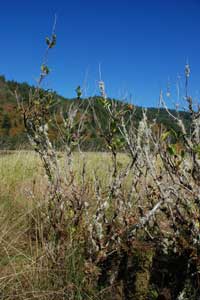
|
Figure A11.
Photograph of salt-stressed black twinberry (Lonicera involucrata)
with epiphytic lichens and mosses in emergent tidal marsh along
the main stem of the Alsea River, Oregon at prioritization site
A17 in fig. 7. The stressed condition of the specimen may be due to high salinity.
Photograph by Christopher Janousek, U.S. Environmental Protection
Agency, September 2010. [larger version]
|
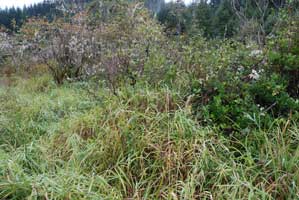
|
Figure A12. Photograph of scrub shrub tidal wetland
at prioritization site Y40 in
fig. 6
in upper Poole Slough, Yaquina estuary, Oregon. Dominant shrubs
are black twinberry (Lonicera involucrata) and Pacific
crabapple (Malus fusca). Photograph by Christopher Janousek,
U.S. Environmental Protection Agency, September 2010. [
larger version
]
|
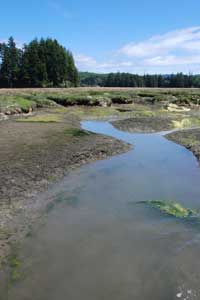
|
Figure A13.
Photograph of low marsh and algal-dominated mudflats at prioritization
site Y34 in
fig. 6
near the mouth of McCaffery Slough in the Yaquina estuary, Oregon.
Photograph by Christopher Janousek, U.S. Environmental Protection
Agency, August 2010. [larger version]
|
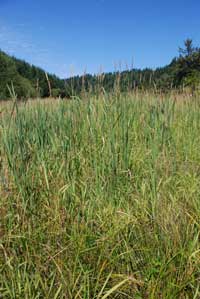
|
Figure A14.
Photograph of tidal marsh at prioritization site Y30 in
fig. 6
in the upper Yaquina estuary with Phalaris arundinacea (reed canarygrass)
growing above other emergent vegetation (e.g., Carex, Potentilla).
Photograph by Christopher Janousek, U.S. Environmental Protection
Agency, July 2010.
[larger version]
|
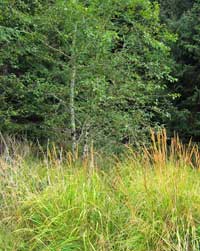
|
Figure A15.
Photograph of red alder (Alnus rubra) on the margin of
tidal marsh at prioritization site A27 in
fig. 7
in the Alsea River estuary, Oregon. Grass in the foreground is Pacific
reedgrass (Calamagrostis nutkaensis), typical of the ecotone
between brackish tidal marsh and brackish tidal swamp. Photography
by Laura Brophy, Green Point Consulting, July 2005. [
larger version
]
|
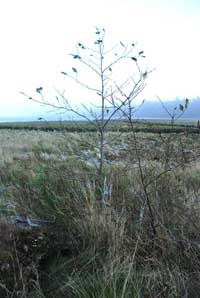
|
Figure A16. Photograph of red alder
(Alnus rubra) growing from a nurse log at prioritization
site Y1 in
fig. 6
in the lower Yaquina estuary, Oregon. Photograph by Christopher
Janousek, U.S. Environmental Protection Agency, November 2010.
[larger version]
|

|
Figure A17.
Photograph of low marsh vegetation in a saline marsh at prioritization
site Y1 in
fig. 6
in the lower Yaquina estuary, Oregon. Photograph by Christopher
Janousek, U.S. Environmental Protection Agency, August 2010.
[larger version]
|
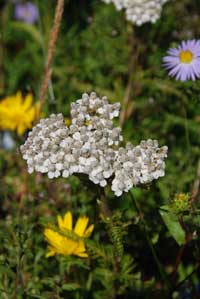
|
Figure A18.
Photograph of Achillea millefolium (common yarrow) flowers in foreground
with Symphyotrichum subspicatum (Douglas aster) and Grindelia stricta
(coastal gumweed) in background found at prioritization site Y1
in
fig. 6
in the Yaquina estuary, Oregon. Photograph by Christopher Janousek,
U.S. Environmental Protection Agency, August 2010.
[larger version]
|
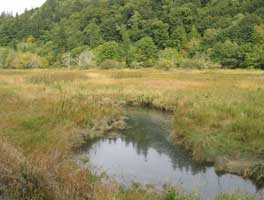
|
Figure A19.
Photograph of high marsh dominated by Carex lyngbyei and
Agrostis stolonifera at prioritization site Y30 in
fig. 6
in the Yaquina estuary, Oregon. Photograph by Laura Brophy, Green
Point Consulting, September 2006. [
larger version
]
|
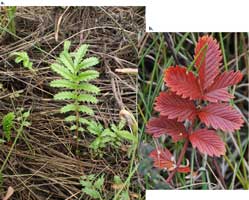
|
Figure A20.
Photographs of Potentilla anserina (Pacific silverweed) at (a) prioritization
site Y13a in
fig. 6
Critesers Marsh in the Yaquina estuary, Oregon and (b) prioritization
site A30 in
fig. 7
in the Alsea estuary, Oregon. A member of the rose family, Pacific
silverweed is a common species in high tidal marsh from Alaska to
California. Photographs by Christopher Janousek, U.S. Environmental
Protection Agency, (a) taken in April 2010 and (b) taken in October
2010.
[larger version]
|
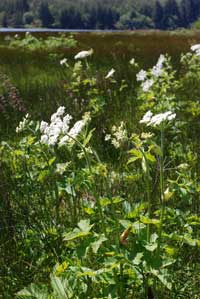
|
Figure A21.
Photograph of Heracleum lanatum (cow parsnip) at prioritization site Y13a in
fig. 6
in Critesers Marsh in the Yaquina estuary, Oregon. Photograph by Christopher Janousek,
U.S. Environmental Protection Agency, May 2010.
[larger version]
|
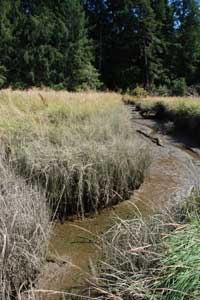
|
Figure A22.
Photograph of a small tributary in estuarine emergent marsh at prioritization site Y40 in
fig. 6
in upper Poole Slough in the Yaquina estuary, Oregon. Photograph by Christopher Janousek, U.S. Environmental Protection Agency, August 2010.
[larger version]
|
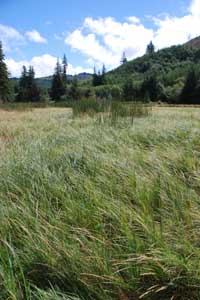
|
Figure A23.
Photograph of estuarine emergent marsh, including a small patch of tall Schoenoplectus sp(p)., at prioritization site Y26 in
fig. 6
at Mill Creek in the Yaquina estuary, Oregon. This wetland was formerly designated by the National Wetlands Inventory as palustrine marsh. Photograph by Christopher Janousek, U.S. Environmental Protection Agency, August 2010.
[larger version]
|
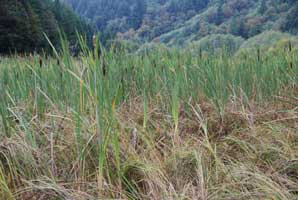
|
Figure A24. Photograph of cattail (Typha
latifolia) marsh at prioritization site Y27 in
fig. 6
in the upper Yaquina River, Oregon. This is a restored tidal wetland, formerly diked; it was previously classified in the National Wetlands Inventory as a seasonally-flooded palustrine marsh with no diking modifier. Photograph by Christopher Janousek, U.S. Environmental Protection Agency, September 2010.
[larger version]
|

|
Figure A25.
Photograph of Oenanthe sarmentosa (water parsley) submerged at high tide at prioritization site Y28 in
fig. 6
in the Yaquina estuary, Oregon. Photograph by Christopher Janousek, U.S. Environmental Protection Agency, November 2010.
[larger version]
|
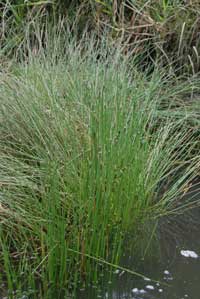
|
Figure A26.
Photograph of Eleocharis palustris (common spike rush) near prioritization site Y29 in
fig. 6
growing at the edge of the river in the upper part of the Yaquina estuary, Oregon. This species is found in lower salinity wetlands. Photograph by Christopher Janousek, U.S. Environmental Protection Agency, August 2010.
[larger version]
|
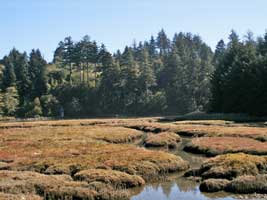
|
Figure A27.
Photograph of low marsh at prioritization site A32 in
fig. 7
in the saline portion of the Alsea estuary, Oregon (mouth of Lint
Slough). Photograph by Laura Brophy, Green Point Consulting, September
2003. [
larger version
]
|
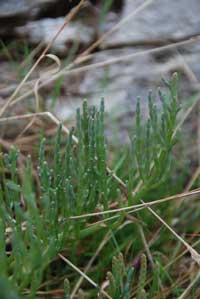
|
Figure A28.
Photograph of Sarcocornia perennis (pickleweed) at prioritization site A30 in
fig. 7
in the Alsea estuary, Oregon. Pickleweed is commonly found in saline low marsh habitat but can also occur at higher tidal elevations in brackish parts of Oregon’s estuaries. Photograph by Christopher Janousek, U.S. Environmental Protection Agency, October 2010.
[larger version]
|
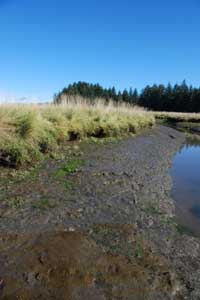
|
Figure A29.
Photograph of tidal marsh and channel banks covered with diatoms and green algae at prioritization site A31 in
fig. 7
in the Alsea estuary, Oregon. Photograph by Christopher Janousek, U.S. Environmental Protection Agency, September 2010.
[larger version]
|
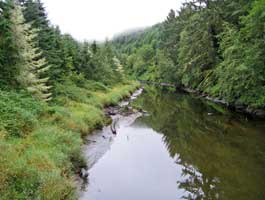
|
Figure A30.
Photograph of tidal freshwater zone near prioritization site A39
in
fig. 7
in Drift Creek, a tidally-influenced palustrine system in the Alsea
River Estuary, Oregon. Photograph by Laura Brophy, Green Point Consulting,
August 2005. [
larger version
]
|
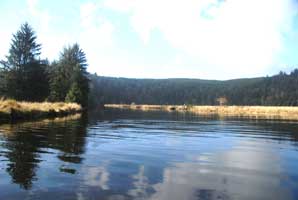
|
Figure A31.
Photograph of Drift Creek and adjoining tidal marshes at prioritization site A26 in
fig. 7
in the Alsea estuary, Oregon. Photograph by Christopher Janousek, U.S. Environmental Protection Agency, November 2010.
[larger version]
|
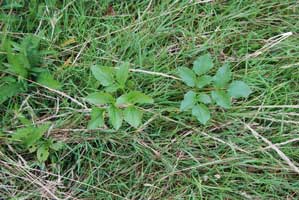
|
Figure A32.
Photograph of Angelica lucida (seawatch angelica) at prioritization site A36 in
fig. 7
close to Eckman Lake in the Alsea estuary, Oregon. Photograph by Christopher Janousek, U.S. Environmental Protection Agency, October 2010.
[larger version]
|